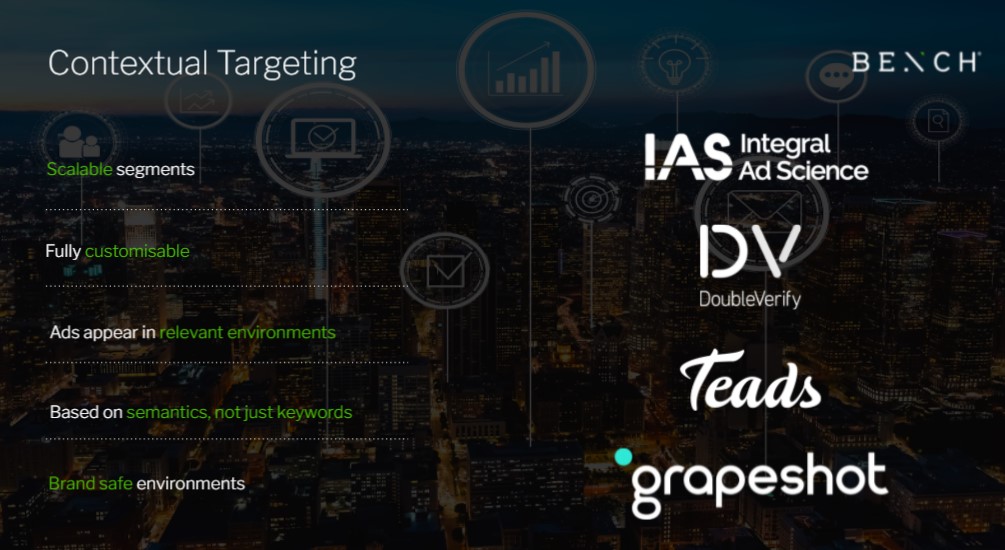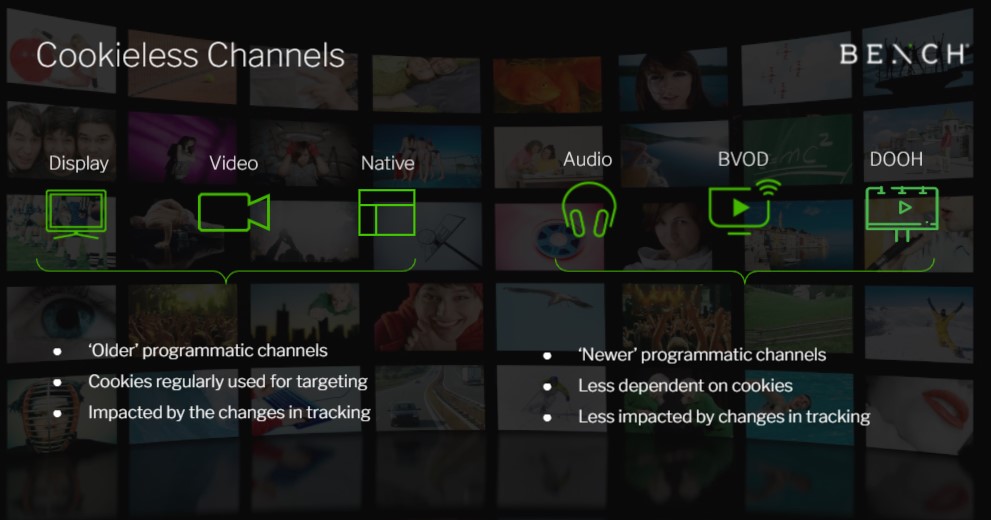Examining non-traditional channels
Contextual targeting and brand-safe environments
Contextual targeting has been a hot topic in recent months and there’s no denying that it’s going to play a massive part in the future of targeting. There are two forms of contextual targeting: digital and physical, with the physical form often referred to as ‘contextual marketing’.
Contextual marketing is the physical, outdoor experience. For example, an adventure clothing brand deciding to run an outdoor ad campaign in and around ski resorts during the winter.
Digital contextual targeting, says Sam Thompson, Head of Media and Partnerships at Bench, is the same approach, but replicated in digital environments. In this case, it’s using the content or context of the web page being viewed to determine the ad content displayed.
“Realistically, both of them are about the right ad for the right brand in the right environment. While this is not new by any stretch, it’s the technology that we’re using which has become a lot smarter,” Thompson explains. “We’ve got contextual semantics engines now that allow us to not only target based on the content of a page, but also allow us to do so in a brand-safe environment.”
For instance, the targeting keywords selected might be right for your brand, but they could also be in a negative context.
Thompson uses an example of the Ruby Princess COVID outbreak in Sydney in April 2020. The NSW state government allowed all 2,650 passengers to disembark without being tested for COVID resulting in 114 cases.
“Without semantics engines, ads for Carnival cruises could have easily appeared alongside all of those negative articles,” Thompson says.
Most of the big players in contextual targeting, such as IAS, Teads, Grapeshot, and Doubleverify, can be accessed off-the-shelf in major demand-side platforms (DSPs). It’s the direct relationship with them that will help organisations yield the most value.
These solutions are a good proxy for audience data. They’re privacy safe as they don’t use any audience data. By increasing sophistication beyond the basic keywords, they shine a light on how valuable contextual targeting can be.
However, Thompson warns brands should be aware there may be limitations to customer personalisation if these tools are used. To overcome this, the content should not be too granular in their targeting and should speak to a group of users
Nevertheless, there isn’t a campaign type that would not benefit from contextual targeting moving forward,” Thompson says. “Organisations get comfortable using and testing these segments in their campaigns because they will become more important as the cookie deprecates.

Geotargeting best practice
Geotargeting creates a unique view of consumers based on their movement patterns. It builds and creates audience segments by analysing where consumers go and how often they go there.
For those who aren’t familiar with geotargeting, these segments are created using signals from background app data on a mobile phone. These providers capture the location data including information about where the person is currently, and where they’ve been. The data is packaged up for brands to activate it across different media outlets.
Ryan Sullivan, Senior Partnerships Manager at Bench, recommends organisations use geotargeting in two ways:
- Proximity targeting: Users are targeted based on where they are at that specific time. For example, a beer brand could use proximity to target people that are physically at a live sporting event.
- Geofencing: Targeting users that enter particular areas. This could be based on where the user has been and the frequency that they visit those locations. For example, a university may want to target people who attend a competitor university. The university could geofence the competitor university campus.
“The reason I like it is because it is quite unique, but it’s accurate. It’s device ID based, it’s consistent down to that user,” Sullivan says. “There’s also a really low radius. A lot of brands like to use it for offline attribution when you’re trying to get down to that store-level accuracy.
“The data is really fresh. It is a real selling point, in my opinion, because these devices are being pinged on a regular basis. I think it’s 200 times a day.”
However, Sullivan notes there are some limitations to these online-to-offline attribution strategies. Marketers need to watch how they use it because localisation can lack scale.
The more niche you become with locations, the less scale they’re going to have,” Sullivan adds. “The upcoming Identifier for Advertisers (IDFA) changes will likely impact scale even further. However, brands do not know what that’s going to look like yet.
As geotargeting gains momentum in marketing campaigns, more interesting use cases are cropping up. Organisations can use it to reach commuters on the daily commute to and from work. They can use it to target CBD workflows within the actual business districts, sports stadiums for sports fans, gyms for health-conscious fitness fanatics, supermarkets for grocery buyers, unions and schools for students and parents, and airports for frequent travellers.
“Geotargeting can be used for point of purchase. For example, if you are Fitness First, you could geofence all the Virgin Active gyms to capture target customers for your marketing campaign. Some of these segments are available off the shelf. But to really get the full value, you do need to develop a direct relationship with one of the providers,” Sullivan says.
Another easy geotargeting method is using the business’s own customer data. Sullivan suggests starting by looking at where the high value customers live, and dial up marketing across those locations.
Brands can do research into lookalike locations, as well. Look at how your audiences are made up and the demographics that are involved there. You can start to target similar locations based on that. Simple but it’s effective,” Sullivan says.
Deep-diving into purchase data
The good news is purchase data is not predominantly cookie-based. These segments will be fairly unaffected by the demise of the cookie.
For instance, Cartology uses Woolworths sales data, while MasterCard uses their own MasterCard purchase data to draw consumer insights. Brands such as Experian and Quantium use financial data from Australian banks like Westpac and Commonwealth bank to further extract insights on consumer spending habits. These are high performing segments, which are heavily used by FMCG, retail, ecommerce, travel and automotive industries.
To access these data points, Thompson suggests marketers have direct relationships with the majority of these players to ingest the data into their own DSPs. In some cases, marketers may need to run through contractual processes to connect those pipes.
As the data is based on actual financial and purchase data signals, Thompson values the deterministic nature of these data sources.
“Where to watch out is that it can lack scale. The data costs are relatively expensive due to the high accuracy of those data sets. Purchase data is generally used a little lower down the marketing funnel as it is generally product or vertical-specific,” Thompson says. “These are usually for the faster moving products. We are looking to target very high intent consumers generally, with a pointed CTA.”
For example, FMCG travel has personal financial data which can be used in different ways. Organisations might use it to build a brand against a high net worth audience, or for purchase decisions that take a little longer such as home loans, cars or luxury goods.
As the industry has evolved, so to have the channels they access, and how they target consumers on them. They now have some channels available to them that are not really dependent on cookie information at all,” Thompson adds.
Digital media and the data-driven future of advertising
Consumption of digital media has expanded, as have the environments people consume media in. From the desktop browser and web browser, to in-app and, Smart TV. User interactions have evolved with technology.
According to Thompson, programmatic channels were relying on cookies, such as standard display, video and native. As these new environments evolved, the cookie became increasingly obsolete.
Thompson points out that the rise of the mobile app was the first major shift away from traditional cookie targeting.
In-app environments, like audio, they don’t support cookies whatsoever. The device IDs became the standard bill, then BVOD came along, which uses household identifiers. If someone is watching on a Smart TV, or watching on a mobile device, neither of these are dependent on cookies,” Thompson says.
Lastly, you’ve got programmatic outdoor channels. Outdoor is one of the oldest forms of advertising and considered one of the most premium. It’s highly rated for building brands, and outdoor does not require cookies whatsoever.
“When you look at this from the top down, there’s no downsides here. You’ve got three scalable channels that are not dependent on cookies whatsoever; BVOD, audio and outdoor. All three are high impact and premium media channels,” Thompson adds.
Thompson reveals the digitisation of these three channels, BVOD, audio and outdoor, has disrupted the entire media industry. Traditionally, these channels were reserved for tier-one brands with millions in marketing dollars.
Now they are way more accessible, the body is totally broken down. That allows us to buy the best media. We know there’s no minimum spend, no huge planning cycles. It has been a huge change in the industry,” Thompson says.

Part 3 of the workshop will posted next week.
Bench Media’s virtual workshop, The Future of Targeting, is available on demand here.
Contact Bench to discuss privacy and cookieless targeting for your brand.




